

| Nottinghamshire invertebrates | ||
| A review of 2013 | ||
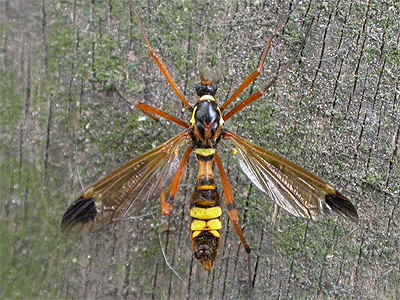 |
Back in July
2009, the discovery of the spectacular RDB1 Crane Fly Ctenophora
ornata at Sherwood Forest
surprised many, especially as the record was isolated and
so much further north than its known UK range. It was a species we had hoped to see again, but after several intervening years of fruitless searches, or hoping for one to turn up at the MV light, we bagan to think that our original record might be isolated, but rather more in occurrence than its UK range. However, reports of 'unusual' numbers of Ctenophora ornata at Windsor, came in an email from John Kramer of the Tipulidae Recording Scheme, to staff at the Sherwood Forest visitor centre in late July. |
|
| ..... | ||
| John's email
was thankfully forwarded to us and just a few nights
later, a follow up moth trapping session produced the
second record for Sherwood Forest, when the male pictured
left, was attracted to our MV light at Clipstone Old
Quarter on 01/08/13. It confirmed the existence of a
viable breeding population at Sherwood Forest, something
we had begun to doubt after the lack of a follow up
record. Ctenophora ornata is not the public's typical perception of a Crane Fly. Its certainly not the Crane Fly they are used to flying around their kitchen light at night, so therefore makes a great example of illustrating to the general public, the unexpected beauty of many of our invertebrates and certainly helps create a greater awareness and interest. |
||
| ..... | ||
| Recent
years have been quite exciting for those interested in
our native Orthoptera (Grasshoppers and Crickets) with
the continued spread of Conocephalus discolor
(Long-winged Conehead) and the arrival and possible
spread of Conocephalus dorsalis (Short-winged
Conehead). Long-winged Conehead was once again present on wasteground at the rear of Tesco's in New Ollerton during August and September, but how long before the site is subjected to development is anyone's guess. Following an initial email we recieved on 25/09/13 and subsequent emails with attached confirmation photographs, we were been able to confrim that Pholidoptera griseoaptera (Dark Bush Cricket) had been recorded in Nottinghamshire for the first time since 2003. The discovery by Weston couple Louise and Alastair Gordon proved extremely important on a county level, being the first Nottinghamshire record since 2003, when it was recorded from the Bingham Linear Park. |
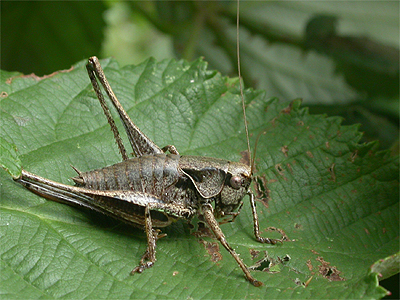 |
|
| ..... | ||
| Louise and Alastair also provided a record of Leptophyes punctatissima (Speckled Bush Cricket) from Weston on 25/09/13. This, coupled with a female we found at Carburton on 16/08/13 and additional records sent in to Roy Frost, the county Orthoptera recorder, proved that Speckled Bush Cricket is definitely increasing its range across Nottinghamshire. Late records of the much commoner Meconema thalassinum (Oak Bush Cricket) came from Sherwood Forest CP on 14/11/13 and then Clipstone Old Quarter on 29/11/13, no doubt helped by the very mild end to the year, with hardly a frost being recorded before the end of the year. | ||
| ..... | ||
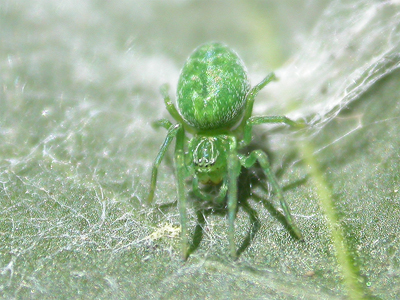 |
After making great
strides through southern counties of the UK and after
having been found in neighbouring Leicestershire and
South Lincolnshire several years ago, it was surprising
that the diminutive, bright green spider Nigma
walckenaeri had not
been recorded in Nottinghamshire before. Nigma walckenaeri (left) was first recorded in Britain at Box Hill and Kew (Surrey) as long ago as 1880 or possibly 1898. It soon became established in Essex around the Thames valley, east Berkshire, Middlesex, London and the rest of Surrey. In 1993 it was found in Worcestershire (where we found it within seconds of looking for it in July 2013) Warwickshire and Gloucestershire and it has been found or recorded regularly there ever since. It can be common in gardens in many parts of its present range, but becomes more difficult to find, the further north you go. |
|
| ..... | ||
| On August
16th 2013, we decided to pay a first visit of the year to
Worksop Priory to look for Harvestmen. In October 2012
the Priory walls were found to hold numbers of the still
un-named Leiobunum Harvestman, which we first
discovered new to the UK at another Worksop location back
in 2009. After walking round the Priory, we decided to
have a casual stroll and search around the old cemetary.
Within a few minutes, a small spider was noticed on the
underside of a Lilac leaf. We were amazed to find that it
was Nigma walckenaeri and the first
record for Nottinghamshire. We often purposefully look in the more unusual places and the tropical house at Woodthorpe Grange on 25/09/13, was an unusual location even by our standards. We recorded a few invertebrates, but one of the spiders present was Parasteatoda tepidariorum. |
||
| ..... | ||
| Parasteatoda
tepidariorum is an introduced spider, which is
largely confined to warm buildings and especially
greenhouses. The increase in garden centres has no doubt
helped in its spread. Apparently known from just one
other Nottinghamshire location prior to this record, it
should be looked for at any garden centres. Another unusual location was King's Mill Hospital, where we found an extensive colony of the large orb-weaving spider Larinioides sericatus around the window frames at the Hospital's main entrance. Much of the colony was later wiped out, possibly by the windows being cleaned, or the spiders thought of as being untidy and frightening. Several Textrix denticulata was found under loose bark on a fallen branch at Budby South Forest on 29/03/13 and 11/04/13, but Zora sylvestris was not found, despite several searches at the nearby Sherwood Forest CP, where rare records of the False Scorpions Chernes cimicoides and Allochernes wideri (right) were both found under bark early in the year. |
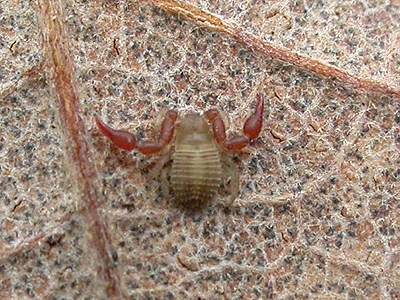 |
|
| ..... | ||
| Opiliones
(Harvestmen) found during 2013 included our first records
of Mitostoma chrysomelas
from under a log at Sherwood Heath SSSI on 02/03/13 and
then another found hunting at night in leaf litter at
Clipstone Old Quarter on 06/10/13. This was a species we
had searched for many times over previous years, as had
been Megabunus
diadema, perhaps the most well marked and
distinctive of all our native species, despite its small
size and which was again found at Wellow Park on 31/05/13
and at Gamston Wood (a new site) on 01/06/13.. At the other end of the size scale is the enormous and still un-named Leiobunum sp, known in the UK from just two sites. We surveyed the colony at Worksop Priory several times and recorded higher numbers than in 2012, with a maximum count of 46 on 22/09/13. |
||
| ..... | ||
| Myriapods and
Isopods (namely Millipedes, Centipedes and Woodlice)
don't do much for many entomologist, but they do make for
interesting study and represent some of our most severely
under-recorded invertebrates. Centipedes and Millipedes
are generally difficult to identify, rarely being
possible from photographs taken in the field, so taking a
specimen is often neccessary. Male Centipedes spin a small web of silk onto which they deposit sperm. The sperm is then picked up by the female, using her modified front legs and can be stored by the female for many months. In early 2013, we found and photographed this act ourselves, when two Lithobius forficatus were discovered on the underside of a log. The male had just deposited the sperm onto the web, which the female collected before making her escape. The photograph below is probably quite unique, as we have yet to trace another showing this procedure on the internet. |
||
| ..... | ||
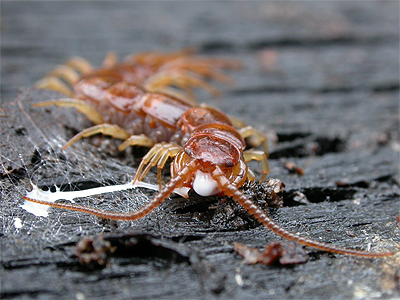 |
With our strong interest
in Glow Worms, it may be that the ability of some species
to bodily glow (bioluminescence) was the key factor in us
taking a greater interest in Centipedes and Millipedes. Accounts of glowing Centipedes are very few and are usually from members of the public out walking late at night. Most accounts of such instances have come during the Autumn months and are always chance encounters. There were very few useful reports on the internet, but there was one on the UK Glow Worm Survey website. But it seems that the few reports there are, all came from members of the public, who's reported sightings often tend to be extremely vague and usually of little accuracy. Myriapod bioluminescence has been recorded by very few naturalists, so we were incredibly fortunate after having our first such encounter in Spring 2012, to followed it up with numerous records of Geophilus easoni bioluminescence in 2013, effectively confirming at least one species' ability to glow to science. |
|
| ..... | ||
| We recorded our second example of bioluminescence produced by a Centipede on April 13th 2013. The Centipede was collected and following examination, turned out to be Geophilus easoni, a heathland species which we regularly find around the Sherwood Forest area. The specimen was found after dark at Clipstone Old Quarter, but was only discovered when it produced a trail of bioluminescent fluid, after almost being trampled on. It did not glow bodily, but the bioluminescent fluid was easily visible from at least two metres away. The bioluminescence lasted between two and three minutes and when caught, we found that pressing down on the Centipede would produce defensive bioluminescence. | ||
| ..... | ||
| Not counting Lithobius
forficatus, Geophilus easoni was found to
be the commonest Centipede in the Sherwood Forest area
and was also recorded from heathland at Walesby Forest. Geophilus
flavus was recorded from the Sherwood Forest CP in
May (the first site record) but not all records came from
the NNR. Geophilus insculptus was found at both Eaton and Gamston Wood near Retford, with Strigamia acuminata also found at the latter site. A new species for Nottinghamshire turned up in Martin Dale's Mapperley garden, in the form of Schendyla nemorensis. The Lithobius Centipedes are difficult to identify, but we recorded Lithobius calceratus from both Clipstone Old Quarter and Sherwood Heath SSSI, while Lithobius muticus turned up in a grass tussock sample from Budby South Forest and Sherwood Forest CP. In Spring, literally hundreds of Tachypodoiulus niger (White-legged Snake Millipede) could be found wandering paths at Clipstone Old Quarter, which is clearly the commonest of all the county's Millipedes. |
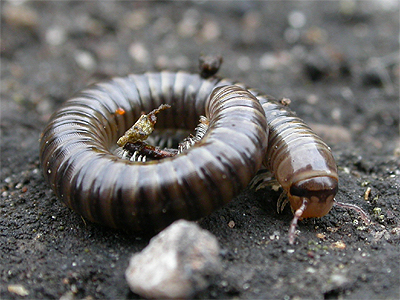 |
|
| ..... | ||
| Cylindroiulus caeruleocinctus (above right) is similar to Tachypodoiulus niger and was found to be more frequent than we had previously thought, being located at a number of sites ranging from Bevercotes Pit Wood to Newstead Abbey. | ||
| ..... | ||
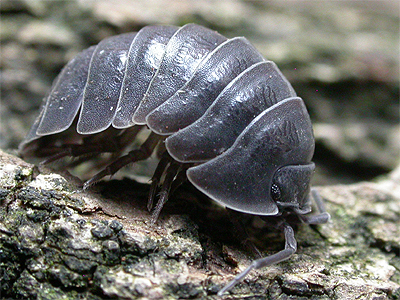 |
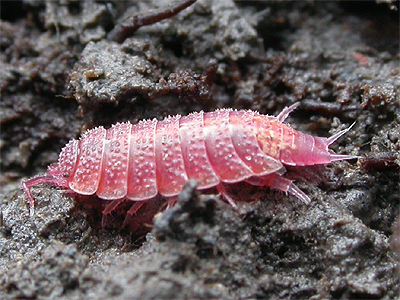 |
|
| ..... | ||
| Above:- Armadillidium
depressum (left) and Androniscus dentiger (right) Isopods (Woodlice) include two species which are certainly among the most widespread of all Nottinghamshire's invertebrates, seen almost daily by many, yet recorded by no one. The Nottinghamshire distribution of Porcelio scaber (Common Rough Woodlouse) based on our own casual records over the years, is shown on the right. Oniscus asellus (Common Shiny Woodlouse) has pretty much the same distribution, but the distribution map for Armadillidium depressum (above left photograph) has just one square. This originates from Nottinghamshire's first ever record, which we found on a stone wall around Carr Bank Park in the centre of Mansfield on 14/04/13, highlighting the usefulness of records obtained from the most unlikely of locations. Armadillidium depressum has a predominantly south-westerly distribution in the UK, with few records approaching south of The Wash. Presumably it is rather under-recorded in the Midlands, rather than being actually scarce. More common is the beautiful pink Androniscus dentiger (Rosy Woodlouse) a species which opened many people's eyes, when we first illustrated it earlier in 2013. We first found this beautifully coloured species under a well rotted section of railway sleeper, on the site of the former Warsop Main Pit Top in April and it is likely to be widespread across Nottinghamshire. Over the years, when scanning through various websites or flicking through books, there are always several species that catch the eye and which you dream of finding one day. So one of our personal highlights of 2013, has to be finally finding one such species. The striking red and black Rhopalid Bug Corizus hyoscyami, was once more or less restricted to coastal areas of the UK, but in recent years the number of inland records increased and it had been found several times in Leicestershire by 2012. It seemed that it was only a matter of time before Corizus hyoscyami reached Nottinghamshire and it was originally thought that one found at Southwell on August 8th by David Yates, was indeed the first Nottinghamshire record. |
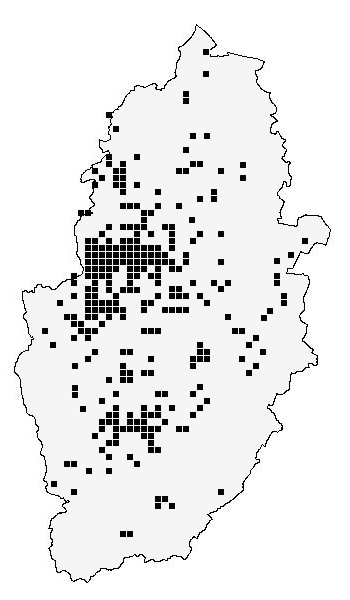 |
|
| ..... | ||
| However, two had been recorded and photographed by Adrian Dutton at Shelford on 20/04/11. Adrian was unaware until recently, that his record was a county first. The Southwell record was hastily followed by another, when a member of the public took a specimen to the visitor centre at Attenborough NR for identification by Tim Sexton. We immediately conducted searches of suitable sites and found two on wasteground at Ollerton on August 18th, before finding another on the rough edge of a field at Market Warsop on 08/09/13. | ||
| ..... | ||
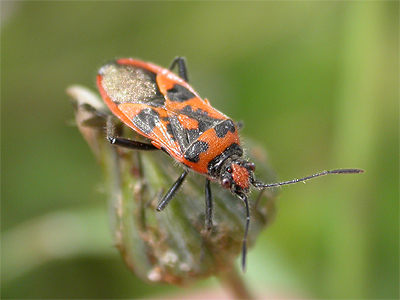 |
While Corizus
represents the more exotic of our native Heteropteran
fauna, other less colourful species found during the
year, were important for their seeming lack of previous
Nottinghamshire records. The Shore Bug Saldula saltatoria is the commonest of the 11 UK species and our only record to date, was from the edges of several shallow pools on the site of the former sand quarry at Market Warsop on 22/04/13. Not colourful by any means and neither was, what seems to be the first county record of the small Mirid Bug Orthocephalus saltator, which turned up at Warsop Main Pit Top on 25/08/13. Invertebrate survey work saw several Psallus perrisi beaten from Oak at Newstead Abbey on 25/06/13, while notable Lygaeidae included records of Ischnodemus sabuleti (European Chinchbug) from both Rufford CP and Meden Vale early in the year. |
|
| ..... | ||
| Nysius
thymi was found during a quick look on a building
site at Forest Town, Mansfield on 31/08/13 and was then
also found near Market Warsop 08/09/13. Our third record of the spectacular leafhopper Ledra aurita, came on an unusually warm and sunny late November day, when found descending a tree near Budby Pumping Station on 27/11/13. |
||
| ..... | ||
| 2013 represented a bumper year for many of the county's moth trappers, with moth numbers increasing after the poor weather in 2012. But not all species are doing well it seems and the very dry Summer of 2013, may well have an impact on some species next year. | ||
| ..... | ||
| Many 'common' species
still appear to be struggling. No doubt for many, this
has been due to a cold, wet flight season in 2012 and a
very dry Summer in 2013, which followed an unusually
prolonged cold spell of weather in the Spring. From our own records, numbers of many of the commoner Crambids (Grass Veneers) are still considerably down. Though micro moths and subsequently often neglected by many recorders, a walk through any grassy site, will often reveal many individuals put up from the long grass. At the light trap, numbers can soon reach hundreds within the space of a couple of hours, but this was not the case in 2012 and remained so throughout 2013. Part of the problem at some Sherwood Forest sites, may be due to the recent over-grazing of some compartments and it is hoped that the site managers will be more mindful of this in the coming years. Not all declines are attributable to over-grazing, but moth numbers are presently suffering at Sherwood Forest, no matter what the cause. |
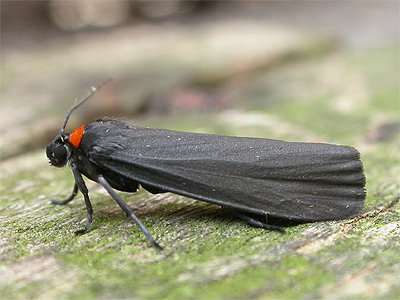 |
|
| ..... | ||
| Its not all
doom and gloom though and two macro moths did provide
welcome Sherwood Forest records during the year. Red-necked Footman is still a great Nottinghamshire rarity, but may just be starting to increase it's range. We trapped two adults at Clipstone Old Quarter on 18/06/13, which were the first record for the Sherwood Forest area since the 1800's. Sheila Wright, the Nottinghamshire county recorder has kindly provided us with details of the county's four other Red-necked Footman records, which include singles at MV light from Thieves Wood near Mansfield, 25/06/11 (SW/JEO); Wellow Wood on 27/06/09 (SW/JEO), Bunny Wood on 29/06/06 (MD/RW) and at Wollaton Park, 24/06/05 (SW). On the same night, we also recorded Pale Oak Beauty, another real Nottinghamshire rarity and one which has escaped many people's light traps. Not quite as large as the aptly named Great Oak Beauty, Pale Oak Beauty is still a large moth, but is not the most attractively marked. We have been lucky with this species, recording it from the Sherwood Forest Country Park in 2008 and from Lound Wood near Eakring in 2007. |
||
| ..... | ||
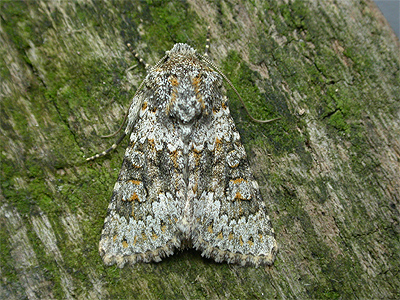 |
Small Ranunculus
is a moth which has spread rapidly north in the past few
years and we eventually recorded our first nectaring at
Valerian in July, then went on to find larvae to be
numerous on Prickly Lettuce around the Market Warsop area
and then at Nettleworth Manor. A moth which should really be deserving of a review of its county status is the Grey Chi. Grey Chi was a moth that we had never seen before and so we were surprised to record two seperate moths on the wall of a house at Mapperley on 28/08/13 and 17/09/13. Further enquiries revealed that this moth was once quite regular at Wollaton Hall (per S. Wright), but its absence in recent years, seems to have passed un-noticed. Some other southern UK counties also mention a recent decline in the numbers of Grey Chi reported. |
|
| ..... | ||
| Above:- Small Ranunculus. Below:- Grey Chi (left) and Beautiful Hook-tip. | ||
| ..... | ||
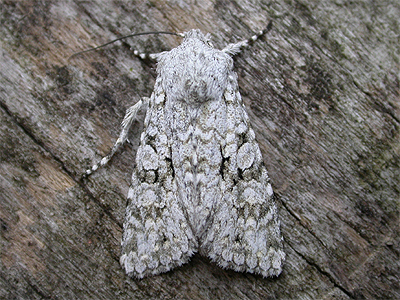 |
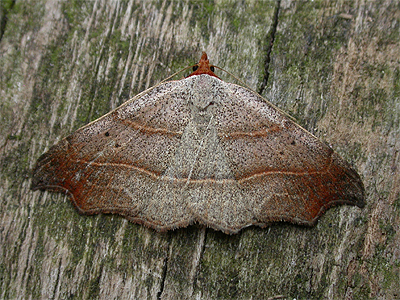 |
|
| ..... | ||
| Its
surprising that you go years without trapping a
particular species, then several turn up in succession. Beautiful
Hook-tip certainly falls into this category for
us and we were particularly pleased to have two turn up
at a light trap we ran at Bevercotes Pit Wood on 20/07/13, quickly
followed by another attracted to an outside light at
Market Warsop on 26/07/13. A single Beautiful Hook-tip then turned up at our MV
light run at Clipstone Old Quarter on 01/08/13. This
record represented the first for the Sherwood Forest NNR,
despite us trapping at this particular spot many times
since 2008. While continuing to trap at Clipstone Old Quarter and occasionally in Sherwood Forest CP and Budby South Forest, we also started to trap at both Gamston and Eaton Woods near Retford and Bevercotes Pit Wood, also returning to Eakring to run a trap at Lound Wood on a couple of occasions. Bevercotes Pit Wood turned up a single Twin-spotted Wainscot on 20/08/13 and good numbers of Red-line Quaker, which seemed to have a good year, as its a moth we had only seen on a few occasions previously. Gamston Wood promises to turn up some nice species and we did get a Pale Pinion on 01/10/13 and two Oak Nycteoline on an unusually mild 11/11/13. However, this is another Nottinghamshire site where the micro moths have been traditionally neglected. |
||
| ..... | ||
| Its a
pity that most recorders give micro moths little time,
especially as they probably make up around 40 or 50% of
the night's catch. Yes there are difficulties in the
identification or seperation of some species, but with
good quality photographs, many can be identified and in
the case of the Stigmellas and Coleophoras,
most can be determined by characteristics within the
leafmine or larval case. Because micro moths are so neglected, their actual distribution across the county is little known and its often surprising what can turn up. A day time visit to Gamston Wood produced a first for Nottinghamshire, when we noticed several black headed Micropterix moths, in with many Micropterix cathella visiting the flowers of Buttercups. We took a few photographs and were subsequently able to confirm them as being Micropterix mansuetella, which is scarce and patchily distributed across the UK. |
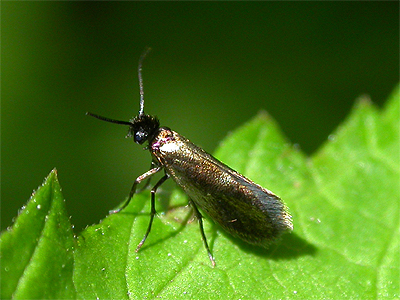 |
|
| ..... | ||
| Trapping at Gamston Wood also produced Ypsolopha
vittella on 14/09/13, Agonopterix liturosa
on 14/08/13 and another over the road at
Eaton Wood on 22/08/13 and three Acleris
cristana of the same colour form
at Gamston Wood on 11/11/13. Other highlights included a
single Agonopterix umbellana attracted to MV
light at Budby SF on 21/09/13 and two Eucosma
pupillana found by day on the
Nottinghamshire Wildlife Trust's Big 50 event at
Attenborough NR on 11/08/13, another moth with very few
VC56 records. Another event we attended, was the RSPB's Cave Critters event at Creswell Crags on the Notts/Derbyshire border, where we were situated under a large Sycamore. Sat on one leaf was the attractive Pammene regiana. Fortunately, we were on the Nottinghamshire side of Creswell Crags, but this should be a common Tortrix at many Nottinghamshire sites. Another Sycamore feeding Tortrix is Pammene aurita, of which a single was attracted to an MV light we ran in Martin Dale's Mapperley garden on 16/08/13. |
||
| ..... | ||
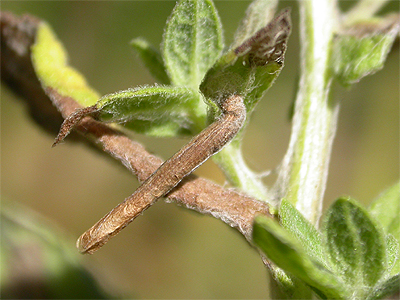 |
Trapping
at Clipstone Old Quarter produced a single Chilo
phragmitella on 01/08/13,
wandering well away from its preferred Reed-bed habitat
and adding a new species to the Sherwood Forest NNR list.
Seven larvae of the Plume Moth Marasmarcha lunaedactyla, were easily located at this moth's only known Nottinghamshire breeding site at Hills and Holes SSSI on 15/06/13, fortunately surviving a fire at the beginning of the year and some deliberate searching for Coleophora larvae both at Hills and Holes and the nearby area, produced the larval cases of Coleophora discordella, Coleophora artemisicolella (first for Nottinghamshire) and Coleophora gryphipenella. However, two large Coleophora cases found on Fleabane, turned out to be those of Coleophora inulae. This is a very local moth of Nationally notable A status, believed to be declining and is found at only a handful of UK sites, most of which are in Hampshire. |
|
| ..... | ||
| 2013 ended up
being the best year for migrant moths since 2006. Good
numbers of Silver Y and Diamond-back Moth were noted, but
we had just two records of Rush Veneer at Warsop Main Pit
Top on 26/09/13 and Lound Wood on 04/10/13, where a Vestal
was the first moth attracted to the light, within seconds
of it being switched on. A Dark Sword-grass was
at Budby South Forest on 22/09/13 and Hummingbird
Hawk-moths visited Valerian in our Market Warsop
garden on 16/06/13, 03/07/13, 30/09/13 and 03/10/13. Renowned migrants the Painted Lady and Red Admiral have long been known to make southerly movements during the late Summer and Autumn months, but both had a relatively poor year despite the excellent Summer weather. We recorded few Red Admirals and just one Painted Lady was eventually seen late in the year. But it was another Nymphalid for which 2013 will be remembered for by many, providing this particular Butterfly with its most exceptional year in several decades and many garden Buddleias were adorned with dozens of this common Butterfly. |
||
| ..... | ||
| The
Peacock is also prone to make migratory movements during
the late Summer. But unlike those of the Painted Lady and
Red Admiral, Peacock movements always seem to pass by
totally unnoticed. We have recorded Peacock Butterflies moving southwards in previous years, although these movements only seem to occur after the emergence of large numbers of adults in favourable years. While travelling around the Mansfield area on 08/08/13, we noticed numerous Peacock butterflies flying across the various roads, all moving purposefully in a westerly direction. Unfortunately, we were unable to conduct a migration watch until mid-afternoon, by which time the cloud was increasing and sunshine was limited, but we still managed a count of 27 Peacocks flying low and direct over a field near Market Warsop. The last big Peacock movement was in 2009, when we recorded 47 moving south-west on 09/08/09, which coincided with a good return movement of Painted Ladies and Large Whites, but a larger movement took place back in 2003, when 106 flew south-west on 03/08/03. |
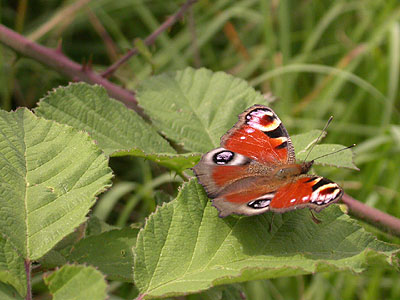 |
|
| ..... | ||
| Again this movement took place in conjunction with several other species. The weather was very hot and dry at the time and movement was thought to have been triggered by the very dry conditions. | ||
| ..... | ||
One of the most exciting finds in recent years, has to be that of the Meloe proscarabaeus (Oil Beetle) colony on Budby South Forest. This is another spectacular, large invertebrate many young entomologists dream of finding or seeing. Following its rediscovery in Nottinghamshire by Adrian Dutton and his wife back in 2011, we have continued to monitor the colony each year. Although progress seems slow, there has been evidence of colony spread. Delayed by the very cold weather during March, when we did make one site visit around mid-month, the first adults were not out until 06/04/13, when 25 (17 males and eight females) were recorded during a thorough survey of the western end of the site. A single female found in a new area, was well away from the main colony and the first real sign of range expansion across the site. |
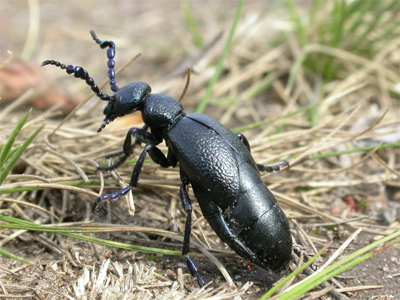 |
|
| ..... | ||
| The following
day (07/04/13) we conducted a second thorough site
survey, this time recording approximately 70 adults. The
count consisted of 34 males and 26 females, but we were
unable to locate Oil Beetles in any additional areas of
the site. Most of the beetles recorded were grazing and
included several mating pairs. A later site visit was
made on 20/04/13, resulting in a count of 41 adults.
Burrowing females, completed burrows containing eggs and
mating pairs were observed. On 22/04/13 we received news of the discovery of Meloe proscarabeus by James Glendenning, at a second Nottinghamshire site. Following a short survey of the site the following day, we located a total of five males and four females. Unfortunately, these were the only live beetles we found and the dead numbered over 25. This new site is located in a very public area of Newstead Abbey grounds. It therefore seems logical to believe that Oil Beetles may also be present at additional Nottinghamshire sites. The Carabid Dyschirius politus preys on species of Bledius Rove Beetles and records are few from Nottinghamshire, so we were pleased to find one above ground at an open sandy site between Edwinstowe and Rufford CP on 04/05/13. |
||
| ..... | ||
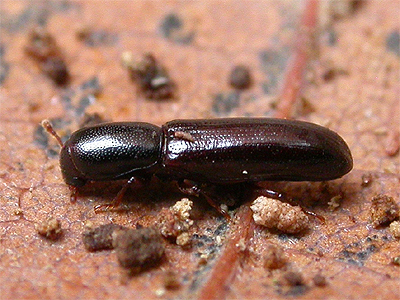 |
The cold March provided
little early beetle activity, but Aphodius
paykulli (Nb) was a nice record in
fresh Horse dung on Budby South Forest on 06/04/13 and
was only the second record for the Sherwood Forest area.
However, it was possible on mild nights to find one RDB1
beetle, but only during the hours of darkness. Teredus cylindricus (left) has been known to occur at Sherwood Forest for many years, but modern Sherwood records are few. We were surprised to find several adults on a dead section of an old Oak at Clipstone Old Quarter in early January 2013, when weather conditions were extremely mild for the time of year. In varying numbers, Teredus cylindricus could be found more or less throughout the year and despite its small size and black colouration, it did create some excitement through being so rare, among the children attending one of our two Glow Worm walks in June and July. The same tree also often held small numbers of Corticeus unicolor, another Red Data Book beetle. Noted several times throughout 2013, we did not record it from other trees it has occured on in previous years. |
|
| ..... | ||
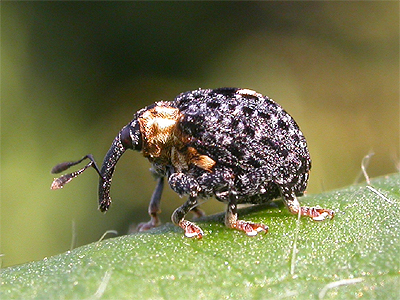 |
We did less work on
surveying for Cryptocephalus coryli
(Hazel Pot Beetle) at Sherwood Forest this year, due
largely to the general lack of interest in the beetle's
presence or status, shown by some of the NNR's management
team. Numbers do appear to be stable and that Cryptocephalus
coryli did seem to have another good year. A
total of ten adults were recorded between 19/05/13 and
30/07/13, with a maximum count of four on 22/05/13. Attending the Nottinghamshire Wildlife Trust's Big 50 event, held at Attenborough Nature Reserve in August 2013, we turned up the Figwort Weevil Cionus tuberculosus, which is very similar to the more common Cionus scrophulariae. It appears to be a first Nottinghamshire record and certainly new for Attenborough NR. Aspidapion aeneum, Aspidapion radiolus, Malvapion malvae and Pseudapion rufirostre were all recorded from Mallow plants growing in the centre of Market Warsop, again illustrating the point that useful records can be obtained from the most unlikely of places. |
|